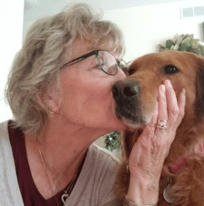As you’re scrolling through RAGOM looking for your next fur baby, you might notice the “another dog required” stipulation on some dogs’ bio page. Sometimes that’s because the dog simply prefers a canine companion and can be more successful in a home with a buddy or two. Other times, it’s because the dog has come from a commercial breeding facility—businesses focused on the production and sale of puppies.
Dogs that come from breeding facilities have experienced life very differently from other dogs. Most have endured psychological stress throughout their lives and have never been socialized or exposed to the normal things a family dog experiences every day.
So initially, navigating life in your home is filled with many scary experiences. These dogs are fearful of almost everything—doorways, stairs, televisions, loud noises, hardwood floors and even the sound of the washing machine. All dogs from these facilities exhibit some level of fear—the severity depends on their personalities and past experiences.
While some dogs respond quickly to a nurturing home environment, others require months or years of rehabilitation. Dayle, who has become known as somewhat of a breeding dog whisperer, has fostered more than 100 RAGOM dogs since 2007. “Many dogs have been returned to RAGOM in the past because they were adopted out to people who didn’t have another dog, and the dog never left its safe spot, never came out of its shell,” says Dayle.
Research finds—and RAGOM’s experience supports—that the single most important factor in rehabilitating breeding dogs is a role model: a confident medium-to large-sized dog who is social with humans and other dogs to help the former breeding dog navigate and become accustomed to their new world.
Here’s why:
- It teaches them how to be a dog. The role-model dog can teach the breeding dog things she can’t learn from humans, such as socialization, not to fear loud or unfamiliar noises, how to play, and most importantly, that humans can be trusted to love and care for them. Over time, the breeding dog might start to realize that the thing she was so scared of is actually nothing to worry about.
- It reduces the intensity of emotional reactions. Role-model dogs can serve as a social buffer for the breeding dog, reducing the intensity of the emotional reaction to something frightening or stressful. Compatibility between the dogs is important—friendship even better!
- It takes the pressure off. When the breeding dog is the only dog in the house, all of the human-dog interaction is focused in one place, which can be too intense for a shy or fearful dog.
- It buys patience and time. When adopters have only one dog in their house and that dog fears them, won’t make eye contact with them, and won’t let them touch her, it’s difficult and frustrating for even the strongest, most loving and most patient of humans. And because we now know that breeding dogs can show these reactions and behaviors for months and even years before improving, the patience this requires when the breeding dog is a person’s only dog would need to be almost superhuman. Having a “normal” dog in the house serves as the outlet for all the love and positive feedback the adopter needs, making it considerably easier for her to give the breeding dog all the time he needs to emotionally recover from the mill experience.
Meet Josie and Maya
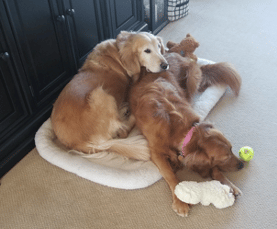
Josie and Maya are real-life success stories of the impact a role-model dog can have on a breeding dog rescue. Adopters Al and Maryann, who had previously adopted Bear from RAGOM, knew they wanted to add to their pack, so they returned to RAGOM to adopt another Golden.
Immediately upon seeing Josie’s face online, they knew she was the one. They met her at foster mom Dayle’s home and spent quite a bit of time getting to know Josie. In April 2018, they brought her home, having no real understanding of what adopting a breeding dog entailed.
As breeding dogs often do, Josie found her safe spot in Al and Maryann’s home. Four months after adopting Josie, Bear unexpectedly passed away. Al and Maryann were devastated. But in those few short months, Bear had taught Josie so much. She had blossomed into a strong, confident dog. Could she possibly be a role-model dog for another breeding dog? Everyone was so impressed with how Josie came around in such a short amount of time, and how she no longer acted like she came from a commercial breeder. The answer was yes! Josie was ready to share what she learned about how to “dog” with a new breeding dog friend.
So, in September 2019, Al and Maryann brought home Maya, who was also fostered by Dayle. It didn’t take long to realize Maya was more fearful and nervous than Josie ever was. Maya hid in the utility room when people came over, refused a leash and insisted on eating off the side of her bed (Maya’s safe spot). Al and Maryann knew they—and Josie—had their work cut out for them.
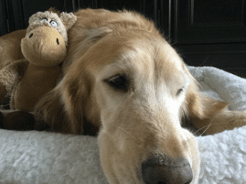
Baby steps
Fast forward 15 months. With time and patience, Maya has blossomed. Now when people come over, Maya joins the party. Her tail wags freely rather than staying tucked under her bottom. She no longer needs to eat off the edge of her bed, and she now stands at the kitchen sink in eager anticipation of mealtime. And after starting slowly with a lariat leash, Maya is now comfortable on a leash.
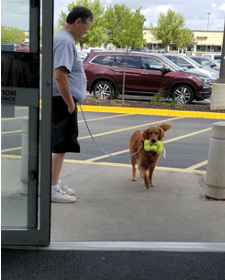
“It takes baby steps,” says Dayle. “It’s not a straight line—the little successes are huge.”
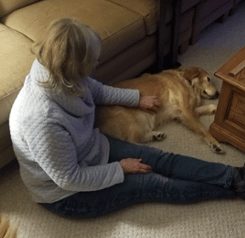
Today, Josie, 7, and Maya, 5, are the best of friends. Josie watches out for Maya in the backyard, and she taught her how to be comfortable in a car. And Maya takes care of Josie, too. When Josie gets scared during thunderstorms, Maya sits with Josie to reassure her.
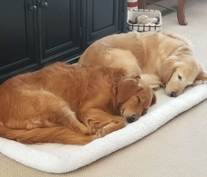
“We’ve seen firsthand the impact a resident dog can have on the breeder dog,” says Maryann. “Breeder dogs are so insecure; everything is strange to them.”
When asked if they would adopt a breeding dog again, they both said “absolutely,” with no hesitation.
“We’ve gotten more love back than we’ve given,” says Al.
